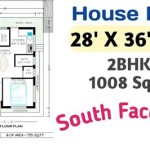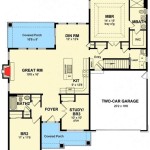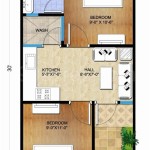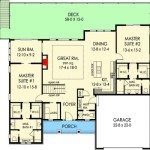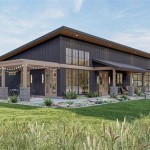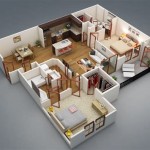Mid-Century Modern Architectural Plans: A Guide to Understanding and Sourcing
Mid-Century Modern (MCM) architecture, a style that flourished roughly from the mid-1940s to the late 1960s, remains highly sought after for its clean lines, integration with nature, and functional design. Understanding the architectural plans associated with this era is crucial for homeowners, preservationists, and architects looking to restore, replicate, or draw inspiration from these iconic structures. These plans offer a window into the design philosophies and construction techniques prevalent during the period, providing invaluable insight into the creation of homes that continue to resonate with contemporary audiences.
The term "Mid-Century Modern" encompasses a broad range of architectural expressions, influenced by Bauhaus principles, Scandinavian design, and the post-war technological advancements in building materials and techniques. These influences are reflected in the architectural plans, which often prioritize open floor plans, large windows, and a seamless connection between indoor and outdoor spaces. Examining these plans allows for a detailed understanding of the spatial organization, material choices, and structural considerations that defined MCM architecture.
Key Elements Found in Mid-Century Modern Architectural Plans
Mid-Century Modern architectural plans are distinguished by several recurring features that highlight the era's commitment to functionality and aesthetic simplicity. These elements are not merely stylistic choices but are integral to the overall design philosophy and contribute to the unique character of MCM homes.
Open Floor Plans: One of the hallmarks of MCM architecture is the open floor plan, which promotes a sense of spaciousness and encourages social interaction. Architectural plans from this period often depict a minimal number of interior walls, with living, dining, and kitchen areas flowing seamlessly into one another. This design approach was a departure from the more compartmentalized layouts of earlier periods and reflects a shift towards a more informal and modern lifestyle. The plans will illustrate how circulation patterns are carefully considered to ensure smooth transitions between different activity zones within the open space.
Emphasis on Natural Light and Views: MCM architecture places a strong emphasis on connecting with the natural environment. This is reflected in the architectural plans, which feature large windows, sliding glass doors, and clerestory windows designed to maximize natural light and offer panoramic views of the surrounding landscape. The orientation of the house is often carefully considered to take advantage of sunlight patterns and prevailing breezes, contributing to energy efficiency and indoor comfort. Plans may also show how landscaping elements are integrated with the building design to enhance the connection between the interior and exterior.
Integration of Indoor and Outdoor Spaces: The seamless integration of indoor and outdoor spaces is another defining characteristic of MCM architecture. Architectural plans often depict patios, decks, and courtyards that extend the living area beyond the confines of the building. These outdoor spaces are designed as integral parts of the overall design, providing opportunities for relaxation, entertainment, and connection with nature. The plans may also show how the building's roofline and overhangs are designed to provide shade and protection from the elements, further blurring the boundaries between inside and out.
Use of New Materials and Technologies: The post-war era saw the development of new building materials and technologies that were readily embraced by MCM architects. Architectural plans often specify the use of materials such as plywood, concrete blocks, and steel, which allowed for greater design flexibility and structural efficiency. The plans may also incorporate details about the use of prefabricated components, which helped to streamline the construction process and reduce costs. These advancements in materials and construction techniques contributed to the sleek, modern aesthetic that defines MCM architecture.
Low-Pitched Roofs and Clean Lines: MCM architecture is characterized by its low-pitched roofs and clean, horizontal lines. Architectural plans typically depict simple, geometric forms that emphasize horizontal planes and minimize ornamentation. This design approach creates a sense of visual calm and reinforces the connection with the surrounding landscape. The plans may also show how the building's massing is carefully considered to create a sense of balance and proportion.
Sourcing Mid-Century Modern Architectural Plans
Obtaining original or reproduction architectural plans from the Mid-Century Modern era can be a complex but rewarding process. These plans are valuable historical documents that provide detailed information about the design and construction of MCM homes. Several avenues are available for sourcing these plans, each with its own advantages and limitations.
University Archives and Historical Societies: Many universities and historical societies maintain architectural archives that may contain plans from the Mid-Century Modern era. These archives often house the papers of prominent architects and architectural firms, providing access to original drawings, specifications, and correspondence related to specific projects. Accessing these archives may require contacting the institution directly and scheduling an appointment to review the materials. While these sources may offer valuable insights into the design process, access to the plans may be restricted due to copyright or preservation concerns.
Online Databases and Repositories: Several online databases and repositories specialize in architectural drawings and historical documents. These resources may offer digitized versions of MCM architectural plans that can be viewed or downloaded for research purposes. These online resources can be a convenient way to access a wide range of plans from different geographical locations. However, the accuracy and completeness of the information should be carefully verified, and the copyright status of the plans should be respected.
Architectural Salvage Companies: Architectural salvage companies often acquire original building materials and documents from demolished or renovated buildings. These companies may have a collection of MCM architectural plans that can be purchased by homeowners or preservationists. Sourcing plans from salvage companies can be a unique opportunity to acquire authentic documents that have a tangible connection to the history of the building. However, the availability of plans may be limited, and the condition of the documents may vary.
Estate Sales and Auctions: Estate sales and auctions can be another source for locating MCM architectural plans. These events often feature a wide range of items from the estate of a deceased individual, including architectural documents. Attending estate sales and auctions can be a time-consuming process, but it can also yield unexpected discoveries. When purchasing plans from estate sales or auctions, it is important to carefully examine the condition of the documents and verify their authenticity.
Reproduction Services: If original plans are unavailable or inaccessible, reproduction services can create accurate copies of existing documents. These services use advanced scanning and printing technologies to produce high-quality reproductions that closely resemble the original plans. Reproduction services can be a valuable option for homeowners who want to preserve the historical accuracy of their MCM homes. However, it is important to obtain permission from the copyright holder before reproducing any protected architectural plans.
Understanding the Information Contained within the Plans
Mid-Century Modern architectural plans contain a wealth of information that is essential for understanding the design and construction of these homes. Deciphering the various symbols, notations, and drawings on the plans requires a basic understanding of architectural conventions and building codes. A thorough review of the plans can reveal valuable insights into the spatial organization, material choices, and structural considerations that defined MCM architecture.
Floor Plans: Floor plans are a fundamental component of any architectural plan set. They provide a top-down view of the building's layout, showing the arrangement of rooms, walls, doors, and windows. MCM floor plans are typically characterized by their open floor plans, which promote a sense of spaciousness and encourage social interaction. The plans will illustrate how circulation patterns are carefully considered to ensure smooth transitions between different activity zones within the open space. Understanding the floor plan is crucial for visualizing the flow of space and the relationship between different areas of the home.
Elevations: Elevations are orthographic projections that show the exterior views of the building from different sides. They provide information about the building's height, roofline, window placement, and other architectural features. MCM elevations often feature clean, horizontal lines and a minimal amount of ornamentation. The elevations may also show how the building is integrated with the surrounding landscape. Studying the elevations can help to understand the overall aesthetic of the building and its relationship to its surroundings.
Sections: Sections are vertical cuts through the building that reveal the interior construction details. They provide information about the building's structural system, wall construction, floor levels, and ceiling heights. MCM sections often show the use of new materials and technologies, such as plywood, concrete blocks, and steel. The sections may also reveal how the building's roofline and overhangs are designed to provide shade and protection from the elements. Reviewing the sections can help to understand the building's structural integrity and the methods used to construct it.
Details: Details are enlarged drawings that show specific construction elements in greater detail. They provide information about the connections between different building components, such as walls, floors, and roofs. MCM details often show the use of innovative construction techniques and the integration of mechanical systems. The details may also specify the type of materials to be used and the methods for installing them. Examining the details can help to understand the building's construction quality and the level of craftsmanship that went into its creation.
Schedules: Schedules are tables that list the specifications for various building components, such as doors, windows, and finishes. They provide information about the size, type, and material of each component. MCM schedules often reflect the era's emphasis on functionality and efficiency. The schedules may also specify the manufacturer and model number of each component. Consulting the schedules can help to understand the quality and durability of the building's materials and finishes.
By understanding the elements and sources of Mid-Century Modern architectural plans, and meticulously studying the information they contain, individuals can gain a deeper appreciation for this influential architectural style and contribute to its preservation for future generations.

Build A House With These Mid Century Modern Floor Plans Blog Eplans Com

Mid Century Modern House Plans Created By The Architects

Build A House With These Mid Century Modern Floor Plans Blog Eplans Com

Designing A Mid Century Modern Home Part Ii Wildfire Interiors

Mid Century Modern House Plans Houseplans Blog Com

P2403

Mid Century Modern House Plan Residential Stock Ilration 102106140 Pixta

Build A House With These Mid Century Modern Floor Plans Blog Eplans Com

205 Home Plans Multi Level Designs Richard Pollman Mid Century Modern House Design

Mid Century Modern House Plans Houseplans Blog Com

